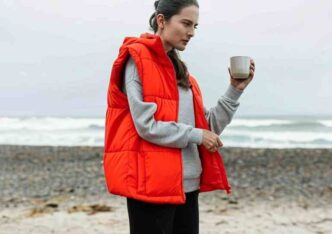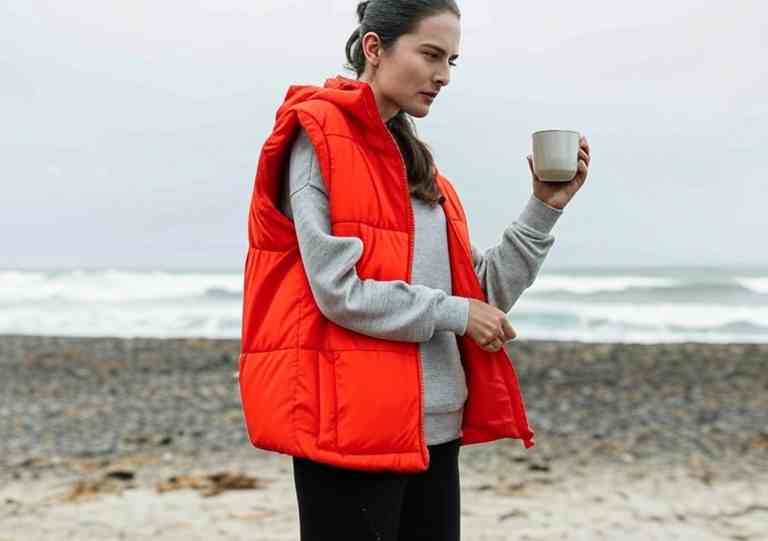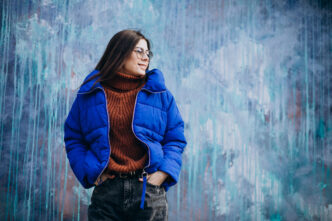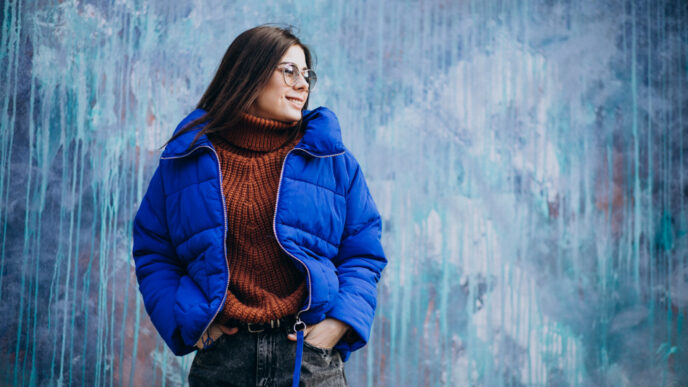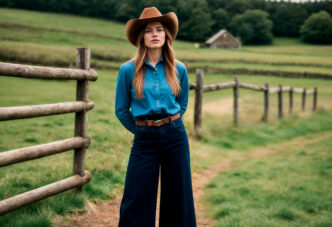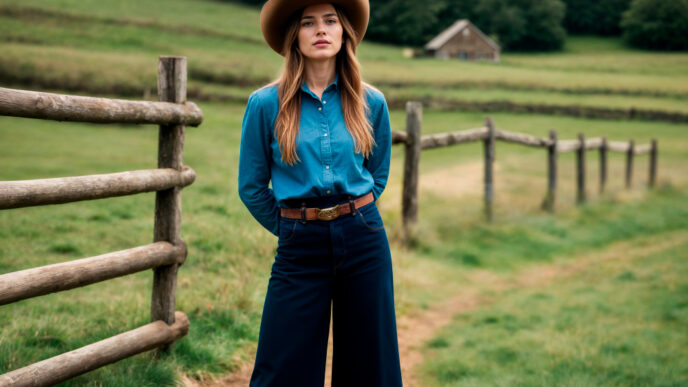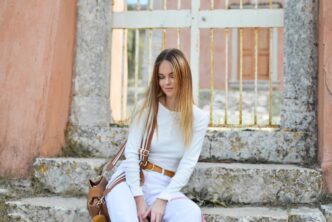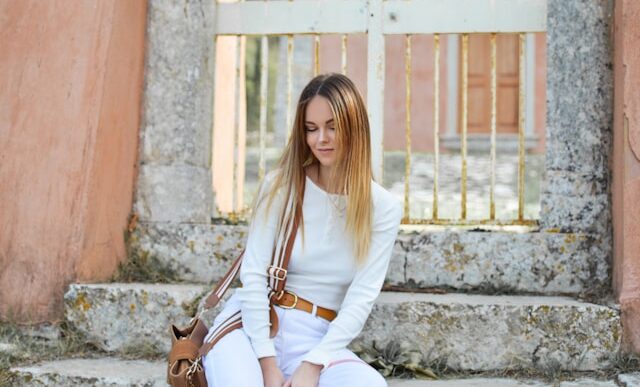Puffer vests are practical pieces that combine warmth with freedom of movement. These quilted layers work across casual and polished looks. Understanding how to style puffer vests helps you create outfits that balance comfort with fashion. This guide covers different ways to wear these versatile pieces. From weekend hikes to city strolls, puffer vests adapt to many settings. The key is choosing pieces that complement your body type while keeping you warm.
Top 10 Puffer Vest Outfit Ideas
Creating balanced looks with quilted outerwear requires attention to proportion and texture mixing that flatters your silhouette.
Puffer Vest with Long-Sleeve Tee
Pairing puffer vests with fitted long-sleeve tees creates casual weekend looks. This combination works well for outdoor activities and errands. Choose tees in neutral colors that complement the vest. The fitted base layer prevents bulk while the vest adds warmth.
Puffer vest outfit for women often features simple base layers that don’t compete with the vest’s volume. Tuck the tee into jeans or leave it loose depending on your preference. Add comfortable sneakers or boots for walking. Layer a scarf when temperatures drop further.
This pairing works across all seasons when you need extra warmth without full jacket coverage. The sleeves provide arm warmth while the vest keeps your core comfortable. Choose moisture-wicking fabrics if you plan active pursuits.
Quality long-sleeve tees maintain their shape through multiple wears. Look for cotton blends that move with you. The fit should be snug enough to layer under the vest without creating bunching or discomfort during movement.
Puffer Vest with Button-Down Shirt
Button-down shirts create polished casual looks when paired with puffer vests. This combination works for weekend activities that require neat appearances. Choose crisp white shirts or subtle patterns that don’t clash with the vest.
Puffer vest outfits benefit from structured pieces that balance the vest’s sporty nature. Roll up shirt sleeves for a relaxed feel. Tuck the shirt into dark jeans or chinos for definition. Add loafers or clean sneakers to complete the preppy aesthetic.
This styling approach works well for casual dining, shopping trips, or family gatherings. The button-down adds refinement while the vest provides practical warmth. Layer over thin sweaters when temperatures require additional coverage.
The key is choosing shirts with the right collar height. Avoid high collars that bunch awkwardly under the vest. Medium-weight fabrics work best for layering without adding excessive bulk around the shoulders and chest.
Puffer Vest with Fitted Sweater
Fitted sweaters create cozy layered looks when combined with puffer vests. This pairing works for cooler weather when you need extra insulation. Choose thin knits that don’t add bulk under the vest.
Women’s puffer vest outfits work beautifully with sweaters that complement the vest’s casual nature. Stick to neutral colors or subtle patterns. Tuck sweaters into bottoms to define your waistline. Add ankle boots or comfortable flats for walking.
This combination provides excellent warmth for transitional seasons. The sweater adds texture while the vest blocks wind. Layer scarves or beanies for additional cold-weather protection.
Quality knits make this pairing successful. Choose sweaters that maintain their shape and don’t pill easily. Merino wool or cotton blends work well for layering. The fit should be close to your body without being restrictive.
Puffer Vest with Denim Jacket
Layering puffer vests over denim jackets creates interesting texture contrasts. This combination works for variable weather when you need adjustable warmth. Choose lighter wash denim for casual looks or dark washes for polish.
How to style puffer vests with denim involves balancing proportions and textures thoughtfully. The rigid denim provides structure while the puffy vest adds warmth. Keep other pieces simple to avoid overwhelming the look.
Add straight-leg jeans and boots for a cohesive denim aesthetic. Choose accessories that complement both pieces without competing. This pairing works well for outdoor concerts, farmers markets, or casual weekend activities.
The key is choosing properly fitted pieces. The denim jacket should allow comfortable arm movement under the vest. Avoid jackets that are too tight or loose as they’ll create unflattering bulk or gaps.
Puffer Vest with Hoodie
Hoodies create athletic-inspired looks when paired with puffer vests. This combination works for active pursuits and casual weekend wear. Choose hoodies in solid colors that coordinate with the vest.
How to wear puffer vests with athletic pieces requires attention to fit and proportion. The hoodie provides base warmth while the vest adds core insulation. Keep the hood down to maintain the vest’s silhouette.
Add joggers or leggings with sneakers for complete athleisure styling. This pairing works well for gym sessions, dog walks, or running errands. Layer fingerless gloves when your hands need warmth but dexterity remains important.
Choose moisture-wicking fabrics for both pieces if you plan physical activities. The hoodie should fit close to your body without restricting movement. Avoid oversized hoodies that create too much bulk under the vest.
Puffer Vest with Thermal Henley
Thermal henleys create outdoor-ready looks when combined with puffer vests. This pairing works for hiking, camping, or cold-weather sports. Choose henleys in merino wool or synthetic blends for warmth and moisture management.
Types of puffer vests for women pair differently with base layers depending on intended activities. Athletic vests work well with performance fabrics. Fashion vests suit cotton or wool blends better.
Add hiking pants or leggings with sturdy boots for outdoor activities. This combination provides excellent temperature regulation during active pursuits. Layer beanies and gloves for extremity warmth.
Quality thermal layers make outdoor activities more comfortable. Look for flat seams that don’t chafe under pack straps. The henley should fit snugly without restricting breathing or movement during exertion.
Puffer Vest with Turtleneck
Turtlenecks create sophisticated casual looks when paired with puffer vests. This combination works for errands, casual dining, or weekend activities. Choose thin knits that don’t add bulk around the neck.
What to wear with puffer vests for polished casual looks often includes refined pieces like turtlenecks. The high neckline provides warmth while maintaining elegance. Stick to neutral colors for maximum versatility.
Add tailored pants or dark jeans with ankle boots for definition. This pairing balances sporty and refined elements successfully. Layer coats over the vest when temperatures require additional coverage.
The turtleneck should fit close to your neck without being tight or restrictive. Choose fabrics that breathe well to prevent overheating. Merino wool provides excellent temperature regulation and comfort.
Puffer Vest with Flannel Shirt
Flannel shirts create cozy outdoor looks when combined with puffer vests. This pairing works for fall activities, hiking, or casual weekends. Choose flannels in classic plaids or solid colors that complement the vest.
Puffer vest outfit ideas for women frequently include flannel for its comfort and warmth. The soft fabric feels good against skin while the vest blocks wind. Leave flannel unbuttoned for layering flexibility or button it for additional warmth.
Add jeans or corduroys with boots for complete fall styling. This combination works well for apple picking, bonfires, or outdoor markets. Layer scarves when neck warmth becomes necessary.
Quality flannel makes this pairing more comfortable and durable. Look for cotton or cotton blends that maintain softness through washing. The fit should allow comfortable layering without creating restrictive tightness.
Puffer Vest with Tank Top
Tank tops create summer transition looks when paired with lightweight puffer vests. This combination works for early morning activities or air-conditioned environments. Choose tanks in moisture-wicking fabrics for active pursuits.
How to dress up puffer vests during warmer weather involves choosing lighter base layers that don’t create overheating. The tank provides minimal coverage while the vest adds core warmth when needed.
Add shorts or cropped pants with sneakers for warm-weather activities. This pairing works well for early morning runs, beach walks, or festival attendance. Remove the vest easily as temperatures rise.
Lightweight vests work best for this combination. Choose packable options that compress small when not needed. The tank should fit comfortably without riding up during movement or activities.
Puffer Vest with Cardigan
Cardigans create layered looks when combined with puffer vests for maximum warmth. This combination works for very cold weather when multiple layers become necessary. Choose thin cardigans that don’t create excessive bulk.
Puffer vest style tips include strategic layering for temperature control and comfort. The cardigan provides adjustable warmth while the vest blocks wind and adds insulation. Keep cardigans unbuttoned for easy temperature adjustment.
Add thermal bottoms and warm boots for cold-weather activities. This combination provides excellent insulation for outdoor events, winter sports, or extended cold exposure. Layer hats and gloves for complete protection.
Choose cardigans in natural fibers that breathe well and provide good insulation. The fit should be comfortable over other layers without restricting arm movement or creating pressure points during extended wear.
Types and Styles of Puffer Vests
Understanding different quilted vest varieties helps you choose pieces that suit your needs and style preferences.
Classic puffer vests feature traditional quilted construction with down or synthetic insulation. These designs provide excellent warmth-to-weight ratios while maintaining compressible convenience. Standard quilting patterns distribute insulation evenly for consistent warmth.
Fitted puffer vests create feminine silhouettes through tailored construction and strategic seaming. These designs follow body contours more closely than traditional styles. The fitted approach works well for layering under coats or over form-fitting base layers.
Oversized puffer vests offer contemporary styling through relaxed fits and extended lengths. These designs provide generous coverage while creating fashion-forward silhouettes. The loose construction accommodates multiple layers comfortably.
Cropped puffer vests hit at or above the waist for modern proportions. These abbreviated styles work well with high-waisted bottoms and create balanced looks. The shorter length prevents overwhelming petite frames while maintaining core warmth.
Long puffer vests extend past the hips for maximum coverage and warmth. These designs work like sleeveless coats and provide excellent protection from wind and cold. Extended lengths create dramatic silhouettes while maximizing insulation.
Hooded puffer vests include attached hoods for additional head and neck protection. These designs provide versatile coverage options without requiring separate hats. Removable hoods offer styling flexibility for different occasions and preferences.
Lightweight puffer vests use minimal insulation for mild weather warmth. These designs pack small and weigh little while providing wind resistance. Summer-weight options work well for air-conditioned environments or cool evenings.
Technical puffer vests incorporate performance features like water resistance, breathable fabrics, or specialized insulations. These designs cater to outdoor activities and athletic pursuits. Technical features enhance functionality without sacrificing style.
Fashion puffer vests emphasize style over pure performance with decorative details, premium materials, or unique silhouettes. These designs work well for urban environments and casual social settings. Fashion elements include fur trim, metallic finishes, or designer quilting patterns.
Reversible puffer vests offer two looks in one garment through different fabric treatments on each side. These designs provide styling versatility and value. Common combinations include solid and patterned sides or different color options.
How To Choose The Best Puffer Vest
Selecting the right quilted vest requires considering insulation type, fit, features, and intended use for optimal satisfaction.
Determine your primary activities and weather conditions where you’ll wear the vest most frequently. Outdoor activities require different features than urban wear. Consider temperature ranges and activity levels when evaluating insulation needs and breathability requirements.
Evaluate insulation types based on your priorities and preferences. Down provides superior warmth-to-weight ratios but loses insulation when wet. Synthetic fills maintain warmth when damp and dry faster. Hybrid designs combine both materials strategically.
Assess fit and sizing carefully since vests must accommodate base layers while maintaining flattering silhouettes. Try vests over typical underlayers to ensure comfortable movement. Consider how the vest will layer under coats for maximum versatility.
Examine construction quality including seam sealing, zipper durability, and fabric strength. Well-made vests maintain their insulation properties through multiple seasons. Quality construction prevents down migration and maintains consistent warmth distribution.
Consider additional features based on your needs and preferences. Pockets provide storage for small items. Adjustable hems allow fit customization. Packable designs compress for travel convenience. Choose features that enhance your intended use patterns.
Evaluate care requirements to ensure they match your maintenance preferences and lifestyle. Some vests require special washing or professional cleaning. Others handle regular home laundering. Consider long-term care costs when making purchasing decisions.
Seasonal Style Guide for Puffer Vests
Adapting quilted vest styling across seasons maximizes their versatility while maintaining appropriate aesthetics and comfort.
Fall Styling Approaches Fall represents peak season for puffer vest styling when temperatures require layering flexibility. Earth tones and rich colors complement autumn’s palette beautifully. Layer vests over long-sleeves, flannels, or light sweaters for temperature control.
Styles of puffer vests work differently in fall conditions depending on regional climate variations. Choose medium-weight insulation for most fall activities. Pair with jeans, corduroys, or casual pants in seasonal colors.
Add boots for warmth and traction on varied surfaces. Scarves provide additional neck warmth when needed. This season allows maximum creativity in combining textures and colors while maintaining practical warmth.
Winter Styling Strategies Winter styling requires strategic layering for maximum warmth while maintaining mobility and style. Heavy insulation vests work well as mid-layers under winter coats. Choose darker colors that hide weather-related wear.
Layer vests over thermal base layers, sweaters, or hoodies for core warmth. Add winter pants, boots, hats, and gloves for complete protection. The vest provides crucial insulation without restricting arm movement.
Technical features become important in harsh winter conditions. Water resistance prevents moisture penetration while breathable fabrics prevent overheating during activity. Choose vests with storm flaps and secure closures.
Spring Styling Techniques Spring transitional weather makes lightweight vests ideal for variable conditions. Morning coolness often gives way to afternoon warmth requiring easy layer removal. Choose packable designs for convenience.
Best practices include pairing lightweight vests with long-sleeves or light sweaters that can be adjusted throughout the day. Add layers gradually as temperatures drop toward evening. Keep styling fresh with lighter colors and clean silhouettes.
Waterproof or water-resistant treatments help during spring rain showers. Choose vests that pack into their own pockets for easy carrying when not needed. This season emphasizes functionality over heavy insulation.
Summer Styling Solutions Summer use focuses on early morning activities, air-conditioned environments, or high-altitude adventures where temperatures drop significantly. Ultra-light vests provide minimal warmth without overheating.
Stylish combinations include pairing summer-weight vests with tank tops, t-shirts, or sleeveless blouses for flexible temperature control. Choose light colors that reflect heat rather than absorbing it.
Packability becomes crucial for summer activities where space and weight matter. Choose compressible designs that disappear into daypacks or travel bags. Technical fabrics that wick moisture prevent discomfort during active pursuits.
Do’s and Don’ts of Wearing Puffer Vests
Understanding proper styling guidelines helps you look polished while staying comfortable in quilted outerwear.
Essential Do’s for Puffer Vest Styling
Do choose vests that fit properly through the shoulders and torso without creating unflattering bulk or restriction. The vest should close comfortably without pulling or gaping. Proper fit ensures both comfort and attractive silhouettes that enhance your natural shape.
Do consider your body type when selecting vest styles and lengths. Longer vests can overwhelm shorter torsos while cropped styles may not provide adequate coverage for longer torsos. Choose proportions that complement your figure while providing desired warmth and coverage.
Do layer thoughtfully to avoid excessive bulk while maintaining warmth and style. Choose thin base layers that don’t compete with the vest’s volume. Strategic layering creates polished looks while providing practical temperature control throughout changing conditions.
Do coordinate colors and textures that complement rather than compete with each other. Neutral vests offer maximum versatility while colored options require more careful consideration. Choose combinations that feel intentional rather than accidental or mismatched.
Do maintain your vest properly through regular cleaning and storage. Follow care instructions to preserve insulation properties and fabric integrity. Proper maintenance extends garment life while maintaining appearance and performance through multiple seasons.
Important Don’ts to Avoid
Don’t wear oversized vests that overwhelm your frame or create unflattering silhouettes. Excessive volume can make you appear larger while hiding your natural shape. Choose fits that provide warmth without sacrificing style or proportion.
Don’t ignore weather conditions when selecting insulation weights and technical features. Heavy insulation in mild weather causes overheating while insufficient warmth leaves you uncomfortable. Match vest specifications to expected conditions and activity levels.
Don’t layer inappropriately by combining pieces that create excessive bulk or restrict movement. Too many layers reduce the vest’s effectiveness while creating uncomfortable pressure points. Choose efficient layering systems that maximize warmth without compromising mobility.
Don’t neglect proper care requirements that maintain the vest’s insulation properties and appearance. Incorrect washing can damage down insulation or reduce synthetic fill performance. Follow manufacturer guidelines to preserve your investment and ensure continued satisfaction.
Don’t forget about style balance when incorporating athletic pieces into non-athletic settings. While versatile, puffer vests work best in casual environments rather than formal or professional settings. Consider appropriateness for your intended activities and social contexts.
7 Tips on How to Wear Puffer Vests
Mastering quilted vest styling requires understanding key principles that enhance both function and fashion.
Tip 1: Master Proportional Balance Creating flattering silhouettes with puffy outerwear requires attention to proportion and volume distribution. Balance the vest’s bulk with fitted pieces elsewhere in your outfit. Choose streamlined bottoms when wearing voluminous tops to maintain visual harmony.
Puffer vest style guide principles emphasize proportion as key to successful styling. Avoid adding bulk in multiple areas simultaneously. Instead, let the vest provide volume while keeping other pieces close-fitting and streamlined.
Tip 2: Choose Quality Insulation Understanding different insulation types helps you select vests appropriate for your climate and activities. Down provides superior warmth-to-weight ratios but requires dry conditions. Synthetic fills maintain performance when wet and dry faster after exposure to moisture.
Recommendations include testing different insulations to understand their performance characteristics. Consider your typical weather conditions and activity levels when choosing between natural and synthetic options. Quality insulation maintains its properties through multiple seasons.
Tip 3: Layer Strategically Effective layering systems maximize warmth while maintaining mobility and style. Start with moisture-wicking base layers that keep skin dry. Add insulating middle layers like the vest for warmth retention. Top with weather protection when conditions require additional coverage.
The key is choosing compatible pieces that work together without creating bulk or restriction. Each layer should serve a specific purpose while contributing to the overall aesthetic. Practice layering combinations to understand what works best for your needs.
Tip 4: Consider Activity Requirements Different activities require different vest features and styling approaches. Urban wear prioritizes style while outdoor activities emphasize performance features. Match your vest choice and styling to your intended activities for optimal satisfaction.
Tips for activity-specific styling include choosing technical features for outdoor pursuits while prioritizing aesthetics for casual urban wear. Consider mobility requirements and weather protection needs when planning outfits.
Tip 5: Coordinate Colors Thoughtfully Color coordination enhances vest outfits while allowing personal expression through thoughtful combinations. Neutral vests in black, navy, or gray coordinate with multiple pieces while providing maximum versatility for various styling approaches.
Look for colors that complement your existing wardrobe while providing the versatility you need. Consider seasonal appropriateness and personal preferences when building your vest collection. Quality basics in neutral colors provide the best long-term value.
Tip 6: Pay Attention to Fit Details Proper fit makes significant differences in both comfort and appearance when wearing puffy outerwear. The vest should provide adequate coverage without overwhelming your frame. Armholes should allow comfortable movement while maintaining insulation effectiveness.
Modern designs often feature tailored fits that provide warmth without excessive bulk. Try different styles to find cuts that work best for your body type and layering preferences. Professional alterations can improve fit when necessary.
Tip 7: Maintain Proper Care Regular maintenance preserves insulation properties and extends garment life significantly. Follow washing instructions carefully to avoid damaging fills or fabric treatments. Store vests properly to maintain loft and prevent compression damage during off-seasons.
Trending care practices include using specialized cleaners for down products and avoiding fabric softeners that can reduce insulation effectiveness. Proper drying techniques restore loft and maintain performance characteristics through multiple use cycles.
Best Alternatives to Puffer Vests
When quilted vests don’t suit your needs, several alternatives provide similar warmth and layering versatility.
Fleece Vests offer lightweight warmth with excellent breathability for active pursuits. These synthetic pieces provide consistent insulation while wicking moisture effectively. Fleece works well for hiking, running, or other high-output activities where temperature regulation matters most.
Wool Vests provide natural insulation with classic styling that works in both casual and refined settings. Merino wool offers excellent temperature regulation while maintaining odor resistance through extended wear. These pieces work beautifully for layering in professional casual environments.
Softshell Vests combine wind resistance with stretchy fabrics for active outdoor pursuits. These technical pieces provide weather protection while maintaining mobility. Softshell designs work well for climbing, cycling, or other activities requiring unrestricted movement.
Quilted Gilets offer similar styling to puffer vests but with different construction techniques and insulation types. These alternatives provide warmth without excessive bulk while maintaining sophisticated appearances suitable for various social settings.
Conclusion
Puffer vests provide practical warmth while maintaining style versatility across multiple seasons and activities. Understanding different styles and styling techniques helps you maximize their potential in various outfits and situations.
Success with quilted outerwear comes from choosing quality pieces that fit properly while learning to layer effectively for both function and fashion. These versatile pieces work well in casual settings while providing reliable warmth for outdoor activities.
By following these guidelines and experimenting with different combinations, you can create comfortable outfits that showcase puffer vests effectively while meeting your practical needs for warmth and style throughout changing seasons.
